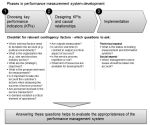Checklist of contingency factors for the performance management system designer
Much research that investigates the contingency factors related to performance management has been published in the last decade. This research often focuses on such questions as the impact of strategy, environmental uncertainty, organizational structure or firm size, existing technology or culture on the effectiveness of performance management. In general, the results of these studies show that certain combinations of contingency factors are more favorable for the success of performance management then others. For example, it has been widely reported that companies pursuing a cost-leadership strategy are better off with formal and highly structured performance management systems. Recent and more complex studies go further and investigate combinations of several contingency factors or even identify new factors that were not previously visible on the academic radar. For instance, the study by Chenhall et al. (2011) went on to understand the relationships between strategy, social networking, culture, and formal controls. The academics build a conceptual model which revealed that the interplay of social networking, culture and strategy together with formal performance controls have an implication on the ability of the company to innovate. For academics, this study (or any other break through research) has a tremendous impact: it shows how our understanding of the world can be improved and the theory of performance management to further developed. But, how does it help the practitioner?
One possible answer is provided by Jääskeläinen et al. (2012). The authors proposed a checklist which can be used by managers during the development of performance management systems. In that list, a generic design process of performance management system was enriched by a list of questions needed to be answered in each process stage. The questions asked by the designer team (typically a consultant team) can help to create an understanding of the relevant contingency factors. I guess, this is how the performance management designer can profit from the academic research.
Checklist based on Jääskeläinen et al. (2012)
References
Chenhall, Robert H.; Kallunki, Juha-Pekka; Silvola, Hanna (2011): Exploring the relationships between strategy, innovation, and management control systems. In Journal of Management Accounting Research 23 (1), pp. 99–128.
Jääskeläinen, Aki; Laihonen, Harri; Lönnqvist, Antti; Palvalin, Miikka; Sillanpää, Virpi; Pekkola, Sanna; Ukko, Juhani (2012): A contingency approach to performance measurement in service operations. In Measuring Business Excellence 16 (1), pp. 43–52.

No trackbacks yet.